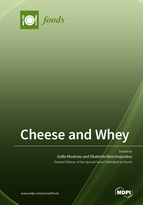Cheese and Whey
A special issue of Foods (ISSN 2304-8158). This special issue belongs to the section "Dairy".
Deadline for manuscript submissions: closed (20 October 2020) | Viewed by 41460
Special Issue Editors
Interests: cheese science and technology; analytical methods; effect of processing on the composition and the biochemical characteristics of milk and dairy products; indices of heat treatment; properties of yoghurt; differentiation of milk from different species; casein genotypes
Special Issues, Collections and Topics in MDPI journals
Interests: food science and technology; food processing; food preservation; functional food; dairy science; dairy technology; dairy microbiology; dairy chemistry; milk quality; milk authedication; milk clotting enzymes; lipase
Special Issues, Collections and Topics in MDPI journals
Special Issue Information
Dear Colleagues,
This Special Issue is dedicated to both products of the cheesemaking process: cheese and whey. Cheese is an excellent and complex food matrix that preserves in concentrated form valuable milk constituents, such as proteins, minerals, vitamins, and biofunctional lipids. The formation of cheese mass requires the removal of whey, i.e., water and soluble milk substances—proteins, minerals, lactose, and vitamins. It is well known that whey, apart from being a serious environmental threat, is a valuable substrate for the formation of new products with excellent functional and biological activities.
Manuscripts related to (i) cheese production, ripening, and properties, and (ii) whey and whey components’ functionality and biological value, as well as whey exploitation and processing, will be presented in this Special Issue.
The submission of regular research papers, reviews, and short communications is encouraged.
Assoc. Prof Golfo Moatsou
Assoc. Prof. Ekaterini Moschopoulou
Guest Editors
Manuscript Submission Information
Manuscripts should be submitted online at www.mdpi.com by registering and logging in to this website. Once you are registered, click here to go to the submission form. Manuscripts can be submitted until the deadline. All submissions that pass pre-check are peer-reviewed. Accepted papers will be published continuously in the journal (as soon as accepted) and will be listed together on the special issue website. Research articles, review articles as well as short communications are invited. For planned papers, a title and short abstract (about 100 words) can be sent to the Editorial Office for announcement on this website.
Submitted manuscripts should not have been published previously, nor be under consideration for publication elsewhere (except conference proceedings papers). All manuscripts are thoroughly refereed through a single-blind peer-review process. A guide for authors and other relevant information for submission of manuscripts is available on the Instructions for Authors page. Foods is an international peer-reviewed open access semimonthly journal published by MDPI.
Please visit the Instructions for Authors page before submitting a manuscript. The Article Processing Charge (APC) for publication in this open access journal is 2900 CHF (Swiss Francs). Submitted papers should be well formatted and use good English. Authors may use MDPI's English editing service prior to publication or during author revisions.
Keywords
- cheese
- whey
- cheese ripening
- whey components
- whey treatment
- functional properties
- nutritional value
- membrane processing








